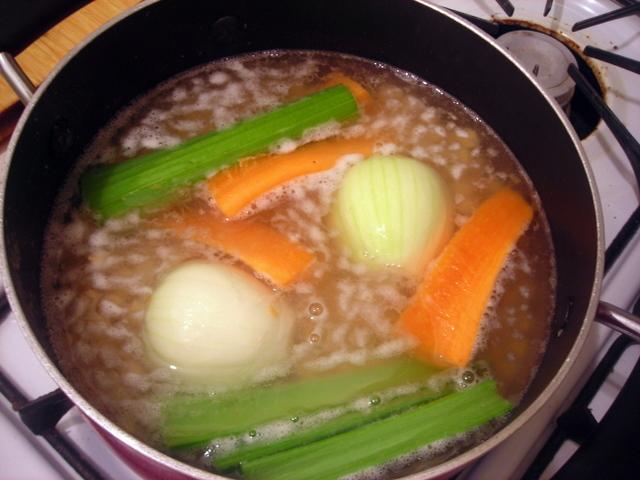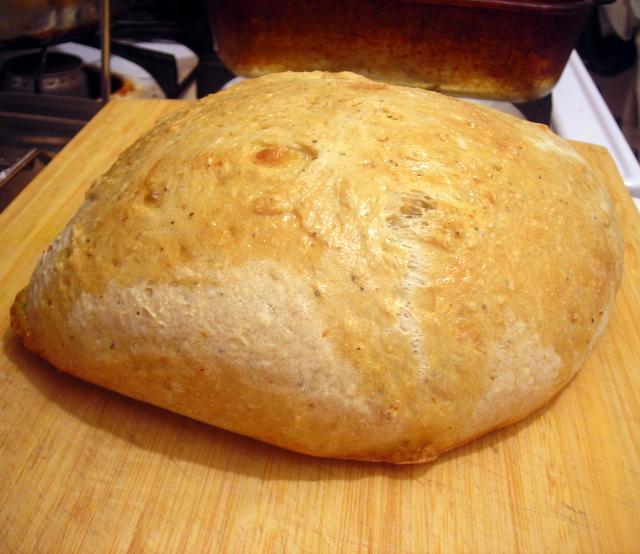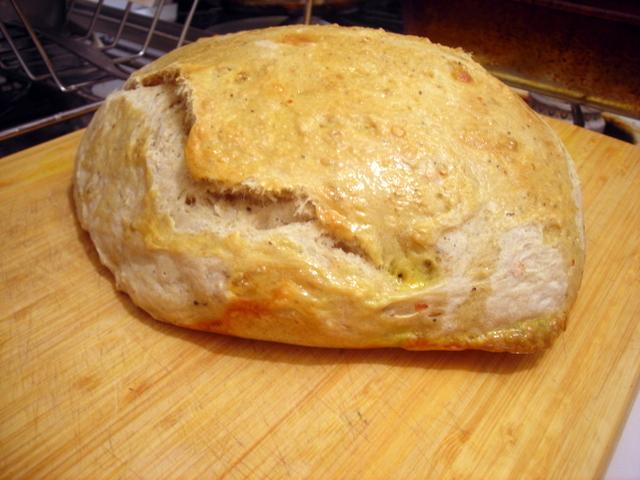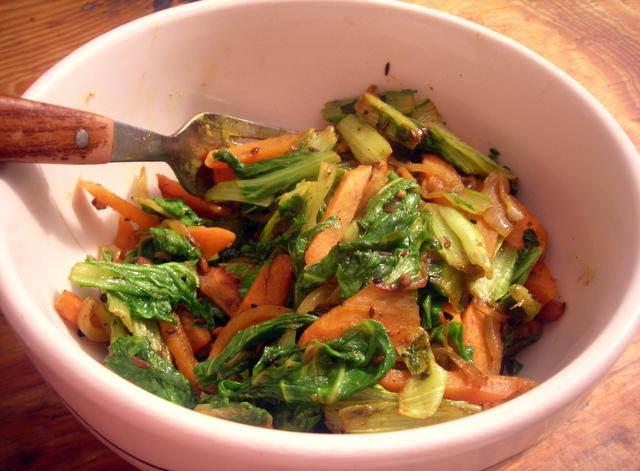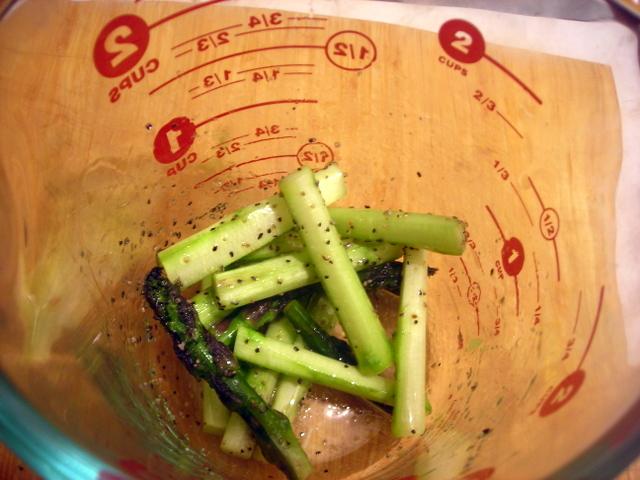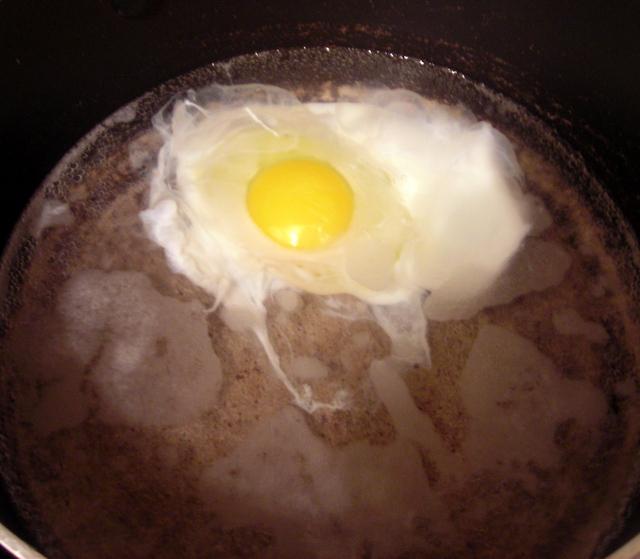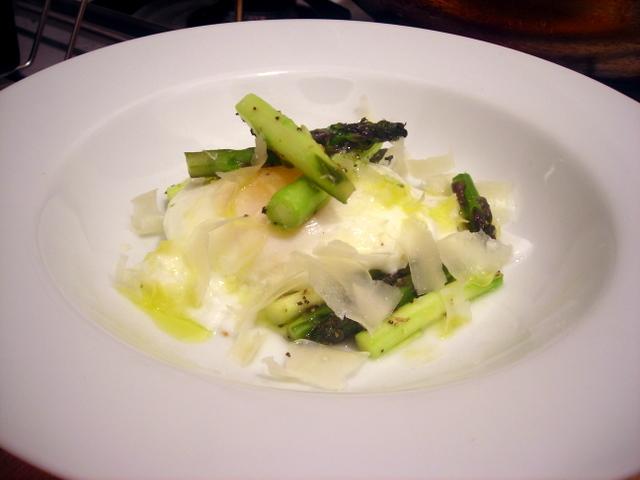-
Posts
7,609 -
Joined
-
Last visited
Content Type
Profiles
Forums
Store
Help Articles
Everything posted by SobaAddict70
-

eG Foodblog: SobaAddict70 (2013) -- La Cuisine du Marché
SobaAddict70 replied to a topic in Food Traditions & Culture
also, it fulfills one of my cooking goals for 2013 -- learning how to bake bread, after which my next thing will be pastry basics, so I can start having things like quiche and galettes for dinner. after all, why should I pay $$$ for mystery bread that stays fresher longer but isn't nearly as flavorful as homemade bread? -

eG Foodblog: SobaAddict70 (2013) -- La Cuisine du Marché
SobaAddict70 replied to a topic in Food Traditions & Culture
oh that. that came out well. nice crumb, good texture. need to use cheddar instead of pecorino next time. less liquid or more flour (3 cups of flour to 1 1/3 cups of warm water was not it). need to slash the top to allow room to expand. guess I'll be baking bread weekly. good thing flour is cheap. not bad for attempt #3. -

eG Foodblog: SobaAddict70 (2013) -- La Cuisine du Marché
SobaAddict70 replied to a topic in Food Traditions & Culture
So, the saga of the broken bathroom pipes continues today, which means I won't be able to do much cooking until the plumbers leave. Sigh. And I won't be able to go to the farmer's market like I wanted to ... fortunately I have a backup plan. Dinner menu for May 31, 2013: Soft-cooked egg, with Red Russian kale, shoulder bacon and wild mushrooms Poached shrimp, spring vegetables Strawberries with orange juice and sugar More later. -

eG Foodblog: SobaAddict70 (2013) -- La Cuisine du Marché
SobaAddict70 replied to a topic in Food Traditions & Culture
Thanks Keith. I try. -

eG Foodblog: SobaAddict70 (2013) -- La Cuisine du Marché
SobaAddict70 replied to a topic in Food Traditions & Culture
Exactly and ditto. Don't have asafoetida, but won't worry about that. Sounds yummy.You can omit the asafoetida (it's there for extra onion flavor) and it will be okay. Incidentally, this technique (the dry-textured method) works with all sorts of starchy vegetables such as turnips and potatoes, as well as some leafy vegetables such as chard and kale. -

eG Foodblog: SobaAddict70 (2013) -- La Cuisine du Marché
SobaAddict70 replied to a topic in Food Traditions & Culture
Chickpeas with Italian tuna, celery and lemon, homemade bread. Recipe follows for the ceci salad: 1 cup ceci (dried chickpeas) 4 cups water + additional water to cover 2 celery stalks, cut in half (you should have 4 pieces excluding the leaves; reserve the leaves) 1 large carrot, peeled, trimmed and quartered 1 onion, peeled, trimmed and cut in half sea salt, to taste 1/4 cup olive-oil packed Italian tuna, drained and mashed with a fork reserved leaves from the celery stalks above 2 tablespoons finely chopped onion juice from half a lemon 4 tablespoons extra-virgin olive oil sea salt and freshly milled black pepper, to taste Cover ceci in 4 cups cold water. Soak for 8 hours, or preferably, overnight. Drain ceci, then place in a pot and cover with cold water. Add celery, carrots, onion and a pinch of sea salt. Bring to a boil, then lower heat and simmer for 1 hour, partly covered, or until chickpeas are tender. You will have at least 1 cup cooked chickpeas; the salad above is sized for two people and uses about 1/2 cup cooked ceci. Mince the reserved celery leaves and set aside. Spoon 1/2 cup of the cooked chickpeas into a bowl. Discard the celery, onion and carrot. Save the remaining chickpeas for other uses. Also consider reserving the chickpea cooking liquid for another use, such as for pasta, for rice, as vegetable stock for soup or sauces. To the 1/2 cup of cooked chickpeas, stir in the tuna, the minced celery leaves, the chopped onion, lemon juice and extra-virgin olive oil. Taste for salt and pepper, then serve at once. -

eG Foodblog: SobaAddict70 (2013) -- La Cuisine du Marché
SobaAddict70 replied to a topic in Food Traditions & Culture
Late dinner tonight after a day of drama waiting for a plumber who had to do work on my bathroom -- and who was 5 hours late, and ultimately left the job half-finished ... *grumble* ... This is approx. 1 cup of ceci (dried chickpeas) that have soaked in 4 cups cold water for 24 hours, then were drained. It's being simmered with 2 stalks celery, 1 large carrot and an onion, along with a healthy pinch of sea salt. Cook for one hour on low heat, partly covered, or until the chickpeas are tender. Reserve the cooking liquid for another use, such as for pasta or rice, or as a vegetable broth for soup. (to be continued once the ceci are done) -

eG Foodblog: SobaAddict70 (2013) -- La Cuisine du Marché
SobaAddict70 replied to a topic in Food Traditions & Culture
I suppose I shouldn't have worried, but next time I'll reduce the amount of liquid since the dough didn't feel "right". I had to add more flour than the recipe called for. If you have "Vegetarian Cooking for Everyone" (by Deborah Madison), this is found on page 667. Will be having this for breakfast tomorrow. -

eG Foodblog: SobaAddict70 (2013) -- La Cuisine du Marché
SobaAddict70 replied to a topic in Food Traditions & Culture
-

eG Foodblog: SobaAddict70 (2013) -- La Cuisine du Marché
SobaAddict70 replied to a topic in Food Traditions & Culture
Have a bowl of yeast in some warm milk on the counter, getting ready to make some peppered-cheese bread. Let's hope this works, LOL. Still a baking n00blet... -

eG Foodblog: SobaAddict70 (2013) -- La Cuisine du Marché
SobaAddict70 replied to a topic in Food Traditions & Culture
Chinese cabbage and carrot, Indian-style. 1 tablespoon ghee 1 teaspoon black mustard seeds 1 teaspoon cumin seeds dried crushed red chile pepper flakes, as desired 1/4 teaspoon asafoetida 1 onion, peeled, trimmed and thinly sliced 1 medium carrot, peeled, trimmed and thinly sliced 1 small head Chinese cabbage, coarsely chopped 1/2 teaspoon turmeric 1/4 cup cold water (use as needed) sea salt and freshly milled black pepper, to taste freshly squeezed lime juice, to taste Melt the ghee in a heavy, non-stick skillet over moderately high heat. When hot, add in rapid succession the mustard seeds, cumin seeds and red pepper flakes. When the mustard seeds pop, add the asafoetida, onion, carrot and Chinese cabbage. Cook, shaking the pan, or until the vegetables are soft and nearly tender, about 10 minutes. Reduce heat to low, stir in turmeric and add cold water, tablespoon by tablespoon, or until the vegetables are tender. The idea is to let the vegetables cook in a nearly dry pan by having the water evaporate before adding each successive addition. When done, taste for salt, pepper and lime juice, then serve at once. I decided to finish off the pasta instead from last night (made way too much as usual) so the ceci will be maybe for brunch or dinner tomorrow. Night folks. -

eG Foodblog: SobaAddict70 (2013) -- La Cuisine du Marché
SobaAddict70 replied to a topic in Food Traditions & Culture
Thanks! This is about 5 nearly pencil-thin stalks of asparagus that have been peeled and trimmed, then seasoned with olive oil, sea salt and black pepper. Roast at 350 F for 5-7 minutes. When I first began poaching eggs, I did the whole "vortex" trick (stir with a spoon to create a centrifuge in a pot of simmering water), as well as a drop or two of white wine vinegar. I've since just graduated to slipping the egg into barely simmering water and keeping the heat at a more or less constant low heat level. Note the bubbles in the water. That's about the right stage. Poach for 2-3 minutes or until the egg has reached your desired doneness, then lift out with a slotted spoon. Asparagus, poached farm egg, shaved pecorino Crotonese cheese and extra-virgin olive oil. -
Very nice. Soba will be proud.
-

eG Foodblog: SobaAddict70 (2013) -- La Cuisine du Marché
SobaAddict70 replied to a topic in Food Traditions & Culture
When you say authentic biryani, which are you referring to? I don't mean to be flippant. There are so many kinds from so many regions, especially within India itself. It's a truly, legitimate, honest-to-goodness question. I remember when I visited Sulaymaniyah, Iraq (I'm Kurdish and only lived there for 4 years) and how different their biryani was in comparison to my mom's--who has put a twist on all the traditional, authentic recipes--and the various Indian biryanis I had consumed. Next time she makes it I'll have to snag a picture. I really like your take on biryani, though. Once I learned what I had grown up with was not entirely traditional or authentic Kurdish food, it really changed how I viewed and cooked food. Hi. I said that "tradition" is not the same thing as "authentic". "Authenticity" as you note depends on the region, but I would probably say that it also depends on the village, from family to family or even person to person. "Tradition" on the other hand, means the techniques that are common to the style of cuisine or culture, in this case Indian. The biryani is certainly not authentic -- it uses barley instead of rice, dried cranberries instead of raisins! But the procedure of frying spices in ghee, adding your aromatic vegetables like onion and ginger afterwards, etc. ... follows the same order that you would use to make a typical biryani. When I said "authentic" in the following sentence, I meant, I can create a biryani in an authentic manner (probably by following a recipe written by someone who is knowledgeable, since I'm not Indian and don't have first-hand experience of that style of cuisine). The same things go for carbonara, bourguignon, etc. Yes, I can do all of that. That being said, sometimes I like exploring new territory while still retaining one foot in whatever tradition it is I'm following, so that I don't end up making something outlandish like meatballs with mint and chocolate. Those meatballs sound interesting to put it politely, but probably wouldn't be edible or tasty. Hope that makes things more clear. -

eG Foodblog: SobaAddict70 (2013) -- La Cuisine du Marché
SobaAddict70 replied to a topic in Food Traditions & Culture
Probably gonna be another late night tonight. The combination of meds I'm taking this week has me sleeping a lot -- hence the weird schedule. Good thing I'm on vacation this week. Dinner menu for May 29, 2013: Asparagus, poached egg, pecorino Crotonese cheese Chinese cabbage and carrots, Indian-style Rapini e ceci The app is something that I make quite frequently in the spring, and sometimes later in the year but with other vegetables instead of asparagus. App #2 is better described as 'dry-textured cabbage and carrots with Indian spices'. I don't cook Indian often enough, something that I'd like to do more often. (Speaking of which, I haven't picked up a Chinese cookbook yet, but I'm talking to Mom now, who is better versed on that particular subject than I am.) The main is something I'm concocting, using principles I've learned over the years from cooking vegetables in the Italian manner. I have no clue whether it'll work, but it should be fun nonetheless. Pix later tonight. -
You assume much, my friend. I'll leave it at that.
-
Your point was clear, but it goes back to why my question was relevant. People do their jobs, but their jobs are piecemeal and their methods are given. It is very difficult to judge the guy roasting the chicken by the chicken you get. That is all. That is why it was a reasonable question and not an argument from authority, or whatever pedantic garbage you guys throw around in here. Nevertheless, it is an impression and oftentimes, the sole impression that a kitchen can make. And impressions have consequences ... how many places have gone down because some meals didn't go right? You (and I'm not using "you" to mean *you* but in the generic sense) hope that every item that's sent out makes for a positive impression, and I can understand the point of view from the back of the house, but consider the person ordering the chicken or the omelette or whatever. Most people won't care. There are some who are knowledgeable, and who may or may not speak up. That's why there are standards that should get upheld, like whether an omelette has brown spots or not. For most folks reading this thread, that's not a consideration. After all, it's just food, no?
-
People need to know how to do their jobs and do it them well. That's my point, sorry that it wasn't clear.
-
No, I haven't. I'm sorry, but I don't see how THAT is any way relevant to this thread. Also, a fine use of an argument from authority fallacy. You can disagree with my opinion or even be dismissive, but it is not unreasonable for a customer like me to judge a professional like you (assuming you are one) by your execution.
-
Of course there are other cuisines in the world, but there is a reason why in many culinary institutions, certain techniques that derive from the French culinary tradition are still taught -- knife skills such as brunoise,tournée and batonnet for example, and stock-making for another. The prospective chef candidate might never use any of that in his future career but it's something that's good to know. They're foundational, in the same way that torts and contracts are basic precepts of law, and thus taught to every first-year student in law school, to borrow another analogy. That's why to certain people, making an omelette (oh, I'm sorry, a Parisian omelette) or a roast chicken stands as a standard test with respect to execution. If I'm going to be dropping upwards of $100 which is the going price for dinner for two in a restaurant in Manhattan and the folks in the kitchen can't make a simple roast chicken -- it comes out dry and tasteless, with overcooked meat, flabby skin, etc. -- then I don't care if they can ace sous-vide techniques or are crackshots at Thai, Mexican or Japanese food. Poor cooking skills are poor. They had their best shot and they blew it.
-

eG Foodblog: SobaAddict70 (2013) -- La Cuisine du Marché
SobaAddict70 replied to a topic in Food Traditions & Culture
Scotty -- thank you. So today: Having just woken up (as I went to bed at 5 am, this is what you do when you're on vacation -- I keep odd hours), I'm having leftover pasta for breakfast and soaking some ceci (chickpeas) for dinner. Haven't really devised a menu yet, that will come later once I think about what I want for dinner. As for the rest of this blog week, tomorrow I'll attempt baking bread #3, and if I get around to it, homemade Old Bay seasoning. If not, I'll start a new thread on the forums. Also, since the blog will end on Friday evening, we'll be going out with a bang. More later. -

eG Foodblog: SobaAddict70 (2013) -- La Cuisine du Marché
SobaAddict70 replied to a topic in Food Traditions & Culture
I should add that in the original recipe, there's something like 2 ounces of unsmoked boiled ham, chopped. The principal component of the sauce will be the spinach (2 lbs. fresh spinach or 2 packages of frozen spinach per the recipe; I scaled things down to serve one person), therefore, the spinach should be salted liberally so that the resulting sauce may be as flavorful as possible. -

eG Foodblog: SobaAddict70 (2013) -- La Cuisine du Marché
SobaAddict70 replied to a topic in Food Traditions & Culture
I like this. However, I'm a little wary of your recommendation to "liberally salt" the spinach. Do you squeeze out excess water/salt or do you just cook the "liberally salted" spinach as-is? Depending on what "liberally salted" means I could envision a too-salty dish at the end... I suppose "adequately salted" might do it for me. :-) Or salt it as needed at the table... ;-) That's what Marcella instructs in the recipe -- and I have learned from conversations with her on Facebook that it's not good to willy-nilly disregard her. Now you are just being pedantic. Yes, you squeeze out the excess water in the spinach, then coarsely chop. Then, as you cook the spinach in the melted butter, you "liberally salt". You do this regardless of whether you're using frozen or fresh; I used frozen, but as stated in my original post, I don't buy ingredients for specific recipes, it's just something I had on hand along with fresh ricotta from USGM. A good cook knows that salting is necessary in stages, especially if whatever it is you're making will turn out well. She's not advising you to dump an entire container of salt, but to use your best judgment to season the spinach, something that comes with experience or via questions on forums like this one. -
use the zest for citrus salt.
-

eG Foodblog: SobaAddict70 (2013) -- La Cuisine du Marché
SobaAddict70 replied to a topic in Food Traditions & Culture
Spaghetti con spinaci e ricotta If you have "Essentials of Classic Italian Cooking", this is on pages 162-163 of the 2012 edition and omits the ham. The usual version of the dish contains ham, but I like it without. Contains spinach, ricotta cheese, nutmeg, unsalted butter, sea salt, and Parmigiano-Reggiano cheese. It is essential that the spinach be liberally salted when you make the sauce, since the ricotta will contain very little salt, (and the ham only a minimal amount, if you elect to make the non-vegetarian version). Your pasta should also be cooked in lightly salted water.




